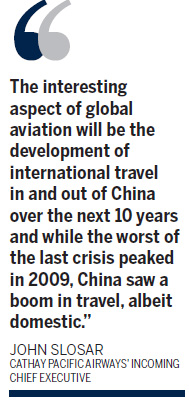Up and away for Cathay
Updated: 2011-01-20 06:56
By Timothy Chui(HK Edition)
|
|||||||||
|
John Slosar, Cathay's incoming chief executive, said he was keen to see how the company could play a role in the development taking place on the mainland. Provided to China Daily |
Despite the uncertainties in the global economy, Cathay Pacific is taking an optimistic outlook. With a new CEO taking the helm in April, the airline plans to make major expansions into the mainland market in the coming year. Timothy Chui reports.
Cathay Pacific Airways' incoming Chief Executive John Slosar says he will preside over the carrier's further integration into the mainland market.
"The interesting aspect of global aviation will be the development of international travel in and out of China over the next 10 years and while the worst of the last crisis peaked in 2009, China saw a boom in travel, albeit domestic," said Slosar, who served for the past 10 years as head man for Swire Pacific Beverages on the mainland.
The airline is moving quickly to expand routes and seek new destinations on the mainland, or to restore old ones, an exception to a global contraction in air travel expansion during the past few years.
Cathay came out of the global economic downturn with a net profit of HK$4.69 billion from 2009 after a stunning loss of HK$8.7 billion the year before.

Slosar, building on Cathay's relationship with Air China, said he was keen to see how Cathay could play a role in the development taking place on the mainland. The two companies will launch a cargo joint venture at the end of this month, with the project having just cleared regulatory hurdles.
On the cargo side, Slosar said the Cathay-Air China partnership would also look into consolidating and building up Shanghai as a hub, while Cathay will push on to construct a HK$5.5 billion state of the art cargo terminal in Hong Kong to maintain the city's edge.
Coming out of the economic downturn, "China as a manufacturing center of the world has come back strongly, and although many people have written that it (the manufacturing) will move elsewhere, we don't see any indication of that. We see that China is coming back stronger than ever, its manufacturing sector is getting more and more capable and doing high value goods and we think that's a great trend for China," Slosar said.
Cargo load factors for the carrier were climbed back to more than 75 percent last year, a new high in recent years and the carrier is looking to meet an 8 percent target in capacity growth this year.
On the passenger side, he said the airline is looking to schedule additional flights beyond the more than dozen daily flights to Beijing and Shanghai as well as to ramp up the number of Dragonair flights into Shanghai's Hongqiao International Airport. Cathay is aiming for an 11 percent increase in overall passenger capacity this year.
Cathay was also keen to boost the number of flights to the next 10 to 12 major cities on the mainland, such as Hangzhou, Nanjing, Xiamen, Fuzhou, Qingdao, Chongqing and Chengdu, he said.
Having worked hand in glove with outgoing Cathay Chief Executive Tony Tyler, who is leaving to take up the chairmanship of the International Air Transport Association in July, Slosar described his working relationship with Tyler during the rough and tumble years of 2009 as seamless teamwork.
"Tony and I, having been around for 30 plus years, understood this deeply in our souls and got down to see what we needed to do, got on and did it. There was very little discussion of demarcation, none of that, we were literally one brain," he said.
The Ohio native said he was eager to interface with customers and figure out how the carrier could do better by them. His Mandarin skills are sufficiently polished to set him in a strong position on the sales and marketing side.
Cathay will begin flying its new business class seats, which cost the carrier HK$1 billion, within the month and is considering premium economy seats as Slosar seeks to build the Cathay brand experience, through further service and schedule improvements, he said.
"What we want to do is to have people experience our service and keep coming back," he added.
Holding on to roughly 1 million passengers in and out of Taiwan and having invested in new seats and planes, of which the carrier will receive 15 this year alone, the carrier is looking to hire another 1,000 cabin crew and at least 500 ground crew this year to staff its planned passenger and cargo expansion.
With demand from interested applicants strong, Slosar maintains Cathay is offering competitive market rates, despite calls by the company's cabin crew union for a pay rise of 8 percent over the next two years.
"In any business, you have to pay market salaries. If you don't you can't attract or retain staff. If you pay double you leave yourself open for competitors to come in and give you a hard time," he said.
Adding together a 13th month bonus and five weeks of profit sharing arrangement, he said most staff received 14-month pay or "a pretty fair package", adding the carrier had paid back in full the unpaid leave it requested staff to take on voluntarily during the leaner months of 2009, with the exception of senior management.
"Although the company's done well, we do share the benefits of good times, but as a business, having seen how aviation works, you can't assume that's the way it will be forever. You can't just give it all away in the good times because you can't recoup it in bad times," he said.
Slosar takes over the Cathay post in April.
(HK Edition 01/20/2011 page3)
